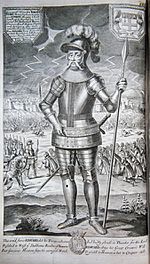Black Monday (1360) facts for kids
Quick facts for kids Siege of Chartres (1360) |
|||||||
|---|---|---|---|---|---|---|---|
| Part of the Hundred Years' War | |||||||
 The History of that Most Victorious Monarch Edward III by Joshua Barnes |
|||||||
|
|||||||
| Belligerents | |||||||
| Commanders and leaders | |||||||
| Strength | |||||||
|
10,000
|
Low | ||||||
| Casualties and losses | |||||||
| 1,000 dead | None/Unknown | ||||||
Black Monday was a terrible storm that happened on Easter Monday in 1360. It took place during the Hundred Years' War, a long conflict between England and France. A sudden and fierce hail storm hit the English army, killing about 1,000 soldiers. This storm was so powerful that it caused more English deaths than any battle in that part of the war.
What Led to Black Monday?
King Edward's March to Paris
On April 5, 1360, King Edward III of England led a huge army towards Paris, the capital of France. This army had about 10,000 soldiers. It was one of the biggest English armies ever seen in the Hundred Years' War.
English Leaders and Their Goal
Edward's army included many famous and skilled commanders. These were men like the Prince of Wales, the Duke of Lancaster, and the Earl of Warwick. Their goal was to make the French army fight them in an open battle.
French Defenses at Paris
The French defenders of Paris were led by Charles, the Dauphin of France. A "Dauphin" was the title for the heir to the French throne. The French leaders decided not to fight the English in an open field. Instead, they stayed safe behind the strong walls of Paris.
Edward's Frustration
King Edward tried for a week to get the French to come out and fight. But all his efforts failed. He couldn't break through their defenses. This meant he couldn't get the big, decisive battle he wanted. So, the English army left Paris. They marched towards the French city of Chartres.
The Siege of Chartres and the Storm
Arrival at Chartres
On Easter Monday, April 13, King Edward's army reached the city of Chartres. Just like in Paris, the French defenders refused to come out and fight. They stayed safe inside their city's walls. This meant the English had to start a "siege." A siege is when an army surrounds a city to try and capture it.
French Defenders
The French defense at Chartres was not very large. It was led by a religious leader, Androuin de La Roche, who was the Abbot of Cluny.
The Sudden Storm
That night, the English army set up their camp outside Chartres. They were in an open field. Suddenly, a huge storm appeared out of nowhere. Lightning struck, and some people were killed right away. The weather became extremely cold very quickly.
Hail and Panic
Then, giant hailstones and freezing rain began to fall heavily. The horses scattered in fear. Two English leaders died during the storm. Panic spread among the soldiers, who had very little shelter. One person described it as "a foul day, full of myst and hayle, so that men dyed on horseback."
Devastation in the Camp
The strong wind tore apart tents. Baggage and supplies were thrown everywhere. In just half an hour, the freezing rain and intense cold killed almost 1,000 English soldiers. Up to 6,000 horses also died. Among those badly hurt was Sir Guy de Beauchamp II. He was the son of the Earl of Warwick. Sir Guy died from his injuries two weeks later.
Edward's Change of Heart
King Edward believed this terrible storm was a sign from God. He thought God was telling him to stop his war efforts. During the worst part of the storm, he got off his horse. He knelt down facing the Cathedral of Our Lady of Chartres. He promised to seek peace. This event convinced him to talk with the French.
Peace Talks Begin
The very next day, Androuin de La Roche, the French leader at Chartres, came to the English camp. He brought ideas for peace. King Edward listened to his trusted advisor, Henry of Grosmont, the Duke of Lancaster. Edward agreed to the peace talks. That day, he began to pull his army away from Chartres. This ended the short, one-day siege.
What Happened Next?
A Friar's Explanation
A French friar named Jean de Venette wrote about the storm. He believed the terrible weather was God's punishment. He said it happened because the English army had been looting the French countryside during the religious period of Lent.
The Treaty of Brétigny
Three weeks after Black Monday, on May 8, 1360, an important agreement was signed. It was called the Treaty of Brétigny. This treaty officially ended the first part of the Hundred Years' War.
Black Monday in History
The event of Black Monday was remembered for a long time. Even famous writer William Shakespeare mentioned it in one of his plays:
“It was not for nothing that my nose fell a- bleeding on Black Monday last, at six o'clock i' the morning.” —Shakespeare: Merchant of Venice, ii. 5.
See also
- Qingyang event

